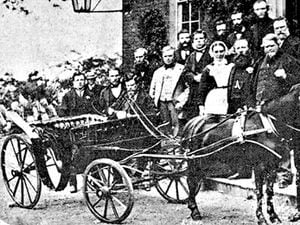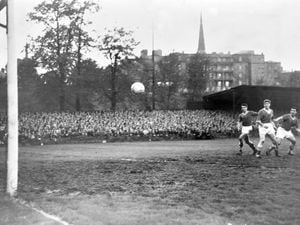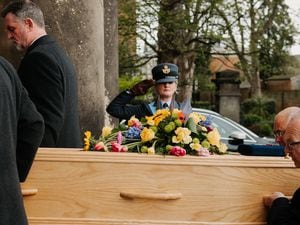Dora's one true love was tending to the sick
Sister Dora didn't enjoy a long life, and it certainly wasn't an easy one. At times it was a messy affair, marred by a controlling father, a troubled family and a complicated love life. And some of the horrors she experienced during her 14 years as a nurse at the height of the Industrial Revolution would have left many people traumatised.

But nobody who witnessed the thousands of factory, foundry and railway workers who clamoured to catch one last glimpse of her coffin as it made its way to the cemetery would ever have questioned that she led a truly great life.
Dorothy Wyndlow Pattison was just 46 years old when she was laid to rest, after her coffin was carried through the streets of Walsall on December 28, 1878. During her last months she continued to tend to the sick and injured of her adopted town, keeping secret the fact that she was dying from breast cancer. So advanced were her methods and so delicate her skills that she was asked to train as a doctor, but that would have meant tearing herself away from the community she had grown to love. And it seems that everything, even the men in her life, came second to her one true love – tending to the sick, wounded and dying of Walsall.
But while the railwaymen, factory workers and shopkeepers turned up in their droves to pay their respects on a cold December day, one man was conspicuous by his absence. Her elder brother Mark, who had been a tower of strength to young Dorothy as she sought to escape the abuse of their controlling father, turned his back on his sister when she decided to become a nurse, believing such work was beneath a member of his family. He refused to attend her funeral.
Born on January 16, 1832, in the remote North Yorkshire village of Hauxwell, Dorothy Wyndlow Pattison was the 11th of 12 children born to the Rev Mark Pattison and his wife Jane, Dora grew up in a volatile and sometimes violent household, badly affected by the declining mental health of her father.
Mr Pattison was the rector of Hauxwell, but became increasingly resentful at his lack of progression in the church. Shortly after Dorothy's birth, the couple's eldest son Mark Jr left home for Oxford University, adding to Mr Pattison's state of depression. In 1835 he had a mental breakdown which saw him sent to an asylum in York, where he was subjected to abusive 'treatments' in an attempt to cure him of his illness.
On his return, his condition worsened, and he blamed his family for sending him to the asylum. He denied his daughters any formal education beyond learning to read and write, and forbade them from marrying.
Left to their own devices, for a while they ran the village school, and became involved in charitable activities such as distributing food and visiting the sick. But the sisters enjoyed a close relationship with elder brother Mark, who tried to help them escape the drudgery their father had planned for them.
Mark Jr became rector of Lincoln College Oxford, and under his influence the sisters became involved with the Oxford Movement, much to the annoyance of their father. Mark was especially close to Dorothy, and would take her on holiday to escape the appalling conditions of her home life, and also offered her education.
Tall, pretty and intelligent, Dorothy was attractive to men and in her 20s she had a couple of relationships. The first was with James Tate, the son of the headmaster of Richmond School. The Tates were close family friends, and James soon fell in love with the attractive 20-year-old. Their on-off relationship saw them engaged three times, but it appears James did not have the stomach to take on Dorothy's domineering father, something which greatly angered her.
At the same time, she was having a secret affair with Purchas Stirke, a young farmer’s son who she met while fox hunting with her sister Rachel. Stirke could not have been more different than Tate, a rugged, uneducated son of toil who her father would have most certainly disapproved of. Rachel went on to marry Purchas's brother Robert, to the fury of Mr Pattison, and was banished from the family home forever.
Dorothy's life would change, though, when her mother Jane became terminally ill, and Dorothy became her full-time nurse. Jane died in 1860, leaving each of her children a £90 share of her will. Even then, £90 was not a huge amount of money – just over £2,000 at today's prices – but it was enough to allow Dorothy to choose the direction she wanted to take in life.
First of all, she broke-off her engagement to James Tate, confiding to Rachel that she preferred Purchas Stirke. But she then decided to end the affair with Purchas too, and used the money to start a new life away from Hauxwell.
Just shy of her 30th birthday, she went to be a village schoolmistress in Little Woolston, near Newport Pagnell, and briefly resumed her relationship with James Tate after a chance meeting on holiday. Then in September 1864, aged 32, she decided to become a nun. Adopting the name Sister Dora, she joined the Coatham Church of England community for women, about eight miles from Middlesbrough.
She wasn't there for long. Four months into the sisterhood, she was sent to Walsall to serve in a new cottage hospital, after another nun had been taken ill.
She initially went to work at Walsall’s first tiny hospital in Bridge Street, before later moving to the cottage hospital at The Mount. Industrial accidents were very common at this time, and in Walsall railway workers in particular found themselves in need of hospital treatment.
In her early days, many working-class men in the town were suspicious of the sisters, believing they would take advantage of the patients' dependence on them to further their message. But Dora proved adept at winning them over, demonstrating a tolerance of their prejudices and a readiness to nurse patients in need of care, regardless of how they responded to her dress or beliefs. She prayed for her patients as well as nursing them, but never used the influence given to her to press her faith on them.
A combination of Dora's outstanding medical skills, coupled with her cheery but no-nonsense manner, led to her developing a great bond of friendship with many of her patients, and the railwaymen in particular.
So great was their love for the nurse, that these modestly paid rail workers managed to raise £50 to pay for a pony and open carriage so that Dora could more easily visit her housebound patients. A dozen of her former patients turned out in their best suits to present her with the carriage in June, 1873.
To begin with, Dora was not well-trained or knowledgeable, even by the standards of the day. But eager to know more, she took every opportunity to learn the latest techniques, and had no problem finding doctors willing to share their skills – and their workload – with her.
She became, in effect, a house surgeon and was so competent that she was pressed by one of the doctors with whom she worked to move to Edinburgh where she could have trained as a doctor. Dora was notably skilled at removing foreign bodies from eyes, and ran a large outpatient clinic where she dealt with many cases without reference to doctors.
In 1875 the town was hit by a smallpox an epidemic, and a special hospital was set up in the unfortunately named Deadman’s Lane – now sensibly renamed Hospital Street – where Sister Dora worked for six months, risking her own life to treat infected patients. Many credited her work during this time, and her obsession with cleanliness in particular, in preventing the town from being over-run by the disease.
The following year, an infection closed the hospital at The Mount, around the same time as an explosion at an ironworks which left many men with horrific injuries. The hospital moved to temporary accommodation rented from the London North-Western Railway in Bridgeman Place, overlooking the town's station.
During 1876, Sister Dora attended 12,127 patients, and it is thought the workload which seriously affected her health. In 1877 she contracted breast cancer. She continued to work, keeping the illness a secret, and when she was no longer able to tend to the patients, she went to London to study Joseph Lister's controversial new work with antiseptics which she was convinced would be the future of medical care. She ordered that all these new measures, which are now basic medical practice, would be implemented in Walsall shortly before her death on Christmas Eve, 1878.
While the affection which the town held for Sister Dora was largely down to her bedside manner, that was not the full extent of her work. She was also an extremely shrewd hospital manager and an adept politician. No doubt influenced by her austere youth, she was highly skilled at ensuring her hospital made the most of its limited funds. Great use was made of student nurses, who not only worked very hard for the hospital, but also paid for the privilege of doing so. Relations were always strained between the doctors and the great-and-the-good in charge of the hospital, but Dora had a knack of striking a balance that kept both sides happy.
In the 1930s a plumber and a decorator working on a large house in the Highgate area of Walsall discovered an envelope of letters in Sister Dora's own handwriting. They revealed that during the last three years of her life, Dora had been in a secret relationship with Kenyon Jones, a prominent businessman 14 years her junior. Given the high profile that both of them would have had, it is clear that they must have made some effort to keep the relationship secret.
Dora's funeral on December 28, 1878 was a spectacle unlike any other that the town had witnessed before. Attended by usual dignitaries, choirs from churches of every denomination, it was most remarkable for the stampede of ordinary working people also wanting to pay their respects. After the official procession entered the cemetery, the gates were closed behind, but so desperate were the masses to see her last moments, that the masses who had been shut out broke them down. Despite this, it is said that they all remained quiet and respectful as she was laid to rest.
A group of working men in the town decided that a straightforward grave was not enough for the much-loved nurse, and began an appeal to pay for a statue in the town.
It took seven years to collect the £1,200 to pay for an 8ft white marble statue of Dora, most of the money coming in small sums from works collecting-boxes. The statue, mounted on a plinth, was unveiled in 1886. By 1957, the years had taken its toll on the marble monument, and the people of the town readily subscribed towards a replacement cast in bronze.
It was one of many monuments around the town dedicated to Dora. In 1895, a railway locomotive was named after her, a fitting tribute to her relationship with the town's railwaymen. In 1988 British Rail also named a modern diesel in her memory.
Each January, the town of Walsall marks Sister Dora's birthday with a service of thanksgiving at her statue in The Bridge. The coronavirus may have led to 'Clap for Carers', but the truth is people in Walsall have been doing it for decades.





